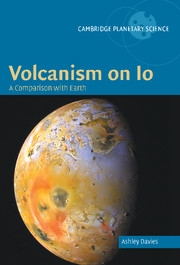Book contents
- Frontmatter
- Contents
- Preface
- List of Abbreviations
- Reproduction Permissions
- Introduction
- Section 1 Io, 1610 to 1995: Galileo to Galileo
- Section 2 Planetary volcanism: evolution and composition
- Section 3 Observing and modeling volcanic activity
- 6 Observations: thermal remote sensing of volcanic activity
- 7 Models of effusive eruption processes
- 8 Thermal evolution of volcanic eruptions
- Section 4 Galileo at Io: the volcanic bestiary
- Section 5 Volcanism on Io: the global view
- Section 6 Io after Galileo
- Appendix 1 Io hot-spot locations
- Appendix 2 Io maps
- References
- Index
- Plate Section
7 - Models of effusive eruption processes
Published online by Cambridge University Press: 05 October 2014
- Frontmatter
- Contents
- Preface
- List of Abbreviations
- Reproduction Permissions
- Introduction
- Section 1 Io, 1610 to 1995: Galileo to Galileo
- Section 2 Planetary volcanism: evolution and composition
- Section 3 Observing and modeling volcanic activity
- 6 Observations: thermal remote sensing of volcanic activity
- 7 Models of effusive eruption processes
- 8 Thermal evolution of volcanic eruptions
- Section 4 Galileo at Io: the volcanic bestiary
- Section 5 Volcanism on Io: the global view
- Section 6 Io after Galileo
- Appendix 1 Io hot-spot locations
- Appendix 2 Io maps
- References
- Index
- Plate Section
Summary
Having identified the location of ongoing or recent volcanic activity and quantified the thermal emission, many questions remain. Is the eruption emplacing flows? How thick are they? How far will they flow? Models of the physical processes taking place can at least constrain the answers to these questions, quantifying the eruption parameters (volumetric flux, areal coverage rate), constraining eruption behavior (total volume erupted, time taken, style of eruption), and allowing comparison with other eruptions, both on Io and Earth.
Volcanology has been transformed over the past four decades by the consideration of the processes taking place from the perspective of applied physics, leading to the development and application of mathematical models of eruption mechanics and flow emplacement. Models are compared with remote and field observations and laboratory studies and then retained and refined – or discarded if found to be unrealistic. The laws of physics being universal, the resulting physical models derived on Earth can be used on other Solar System bodies so long as local conditions are taken into account.
The need for process modeling arose from data collected by the first generations of planetary missions during the 1960s and 1970s, when the importance of large-scale volcanism throughout the inner Solar System was realized, as was the primary role played by basalt (described in the massive Basaltic Volcanism on the Terrestrial Planets, published by the Lunar and Planetary Science Institute [BVSP, 1981]).
- Type
- Chapter
- Information
- Volcanism on IoA Comparison with Earth, pp. 108 - 141Publisher: Cambridge University PressPrint publication year: 2007
- 1
- Cited by

